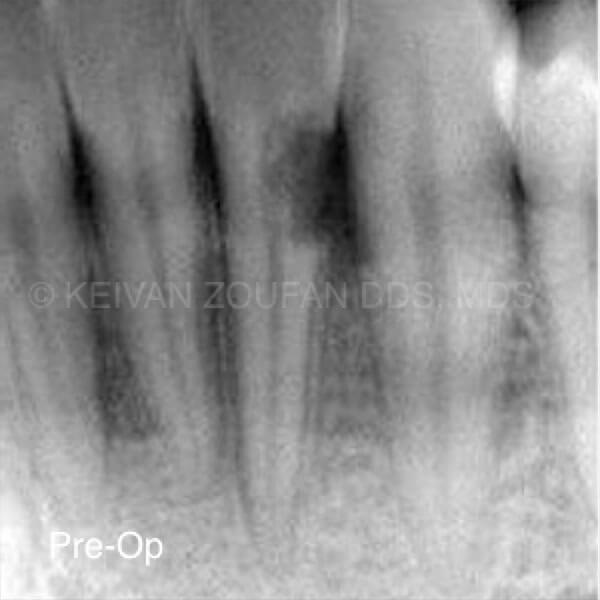Root Resorption Treatment

Root resorption is a complex and potentially devastating dental condition that can lead to the destruction of the root structure of a tooth. It is characterized by the loss of cementum, dentin, and other tissues that make up the root, often resulting in a significant reduction in the tooth’s ability to anchor itself within the jawbone. This condition can be caused by a variety of factors, including trauma, infection, and orthodontic treatment.
When left untreated, root resorption can progress to the point where the tooth becomes loose and potentially falls out. In severe cases, the condition can also lead to the formation of a cyst or tumor within the jawbone, which can cause further damage and discomfort. As such, it is essential to seek prompt and effective treatment for root resorption to prevent these complications and save the affected tooth.
One of the most effective treatments for root resorption is a procedure known as apexification. This involves using a special material, such as calcium hydroxide or mineral trioxide aggregate (MTA), to stimulate the formation of a hard tissue barrier at the apex (tip) of the root. This barrier helps to prevent further resorption and promotes the healing of the surrounding tissues.
In some cases, apexification may be performed in conjunction with other treatments, such as root canal therapy or apical surgery. Root canal therapy involves removing the infected pulp tissue from within the tooth and filling the canal with a special material to prevent further infection. Apical surgery, on the other hand, involves surgically removing the infected tissue and any cysts or tumors that may have formed at the tip of the root.
Another treatment option for root resorption is a procedure known as intentional replantation. This involves surgically removing the tooth from the jawbone and then replanting it after treating the root surface with a special material to promote healing and prevent further resorption. This procedure can be highly effective in saving teeth that would otherwise be lost due to severe root resorption.
In addition to these surgical treatments, there are also several non-surgical options that can be used to manage root resorption. These include the use of medications, such as corticosteroids and non-steroidal anti-inflammatory drugs (NSAIDs), to reduce inflammation and promote healing. In some cases, a dentist or endodontist may also recommend using a special mouthwash or gel to help promote healing and prevent further resorption.
Overall, the key to successful treatment of root resorption is early diagnosis and intervention. By seeking prompt and effective treatment, individuals can help prevent the progression of this condition and save their teeth from further damage. It is essential to work with a qualified dentist or endodontist who has experience in treating root resorption and can recommend the most effective treatment options for each individual case.
Causes of Root Resorption
Root resorption can be caused by a variety of factors, including:
- Trauma: A blow to the mouth or face can cause the tooth to become displaced or damaged, leading to root resorption.
- Infection: Bacterial infections, such as those caused by gum disease or abscesses, can damage the tissues surrounding the root and lead to resorption.
- Orthodontic treatment: The application of excessive force during orthodontic treatment can cause the root to become damaged and lead to resorption.
- Genetic predisposition: Some individuals may be more susceptible to root resorption due to genetic factors.
Diagnosis and Treatment
Diagnosing root resorption typically involves a combination of clinical examination, radiographic evaluation, and histological analysis. A dentist or endodontist will examine the tooth and surrounding tissues to look for signs of damage or infection, and may use X-rays or other imaging techniques to evaluate the extent of the resorption.
Once the diagnosis has been made, the dentist or endodontist can recommend the most effective treatment options for each individual case. This may involve surgical or non-surgical treatments, depending on the severity of the condition and the overall health of the tooth and surrounding tissues.
Step-by-Step Guide to Treating Root Resorption
- Seek prompt and effective treatment from a qualified dentist or endodontist.
- Undergo a thorough clinical examination and radiographic evaluation to determine the extent of the resorption.
- Discuss treatment options with the dentist or endodontist, including surgical and non-surgical approaches.
- Follow the recommended treatment plan to promote healing and prevent further resorption.
- Schedule follow-up appointments to monitor the progress of the treatment and make any necessary adjustments.
Prevention
While root resorption can be a challenging condition to treat, there are several steps that can be taken to prevent it from occurring in the first place. These include:
- Practicing good oral hygiene, including regular brushing and flossing to prevent infection and damage to the teeth and surrounding tissues.
- Avoiding traumatic injuries to the mouth and face, such as those caused by sports or other activities.
- Seeking prompt and effective treatment for any dental problems, such as infections or abscesses.
- Working with a qualified dentist or orthodontist to ensure that orthodontic treatment is applied carefully and safely.
By taking these steps, individuals can help prevent root resorption and promote overall oral health.
Pros and Cons of Different Treatment Options for Root Resorption
| Treatment Option | Pros | Cons |
|---|---|---|
| Apexification | Can stimulate the formation of a hard tissue barrier to prevent further resorption | May require multiple visits to the dentist or endodontist |
| Root Canal Therapy | Can remove infected pulp tissue and prevent further infection | May be painful or uncomfortable |
| Intentional Replantation | Can save teeth that would otherwise be lost due to severe root resorption | May be a complex and invasive procedure |

Conclusion
Root resorption is a complex and potentially devastating dental condition that can lead to the destruction of the root structure of a tooth. However, with prompt and effective treatment, individuals can help prevent the progression of this condition and save their teeth from further damage. By understanding the causes and treatment options for root resorption, individuals can take the first step towards preserving their oral health and preventing the need for more extensive and costly treatments down the line.
What are the symptoms of root resorption?
+The symptoms of root resorption can vary depending on the severity of the condition, but may include pain, sensitivity, or looseness of the affected tooth.
How is root resorption diagnosed?
+Diagnosing root resorption typically involves a combination of clinical examination, radiographic evaluation, and histological analysis.
What are the treatment options for root resorption?
+Treatment options for root resorption may include apexification, root canal therapy, intentional replantation, and other surgical and non-surgical approaches.


